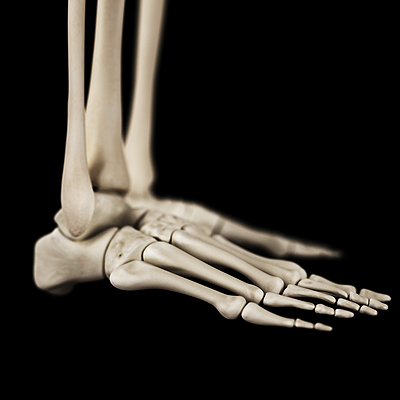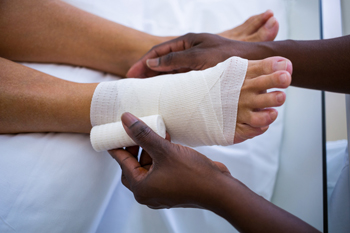Items filtered by date: August 2023
Exploring Foot Bones and Conditions Impacting Them

Beneath the skin's surface lies a fascinating framework of foot bones, intricately designed to support our weight and enable movement. Comprising 26 bones, the foot forms three arches that are crucial for balance and shock absorption. However, this intricate structure is vulnerable to various conditions. Fractures can occur due to accidents or stress, while arthritis, an inflammation of joints, can erode bone surfaces. Bunions, caused by misalignment of bones, lead to a bony bump at the base of the big toe. Plantar fasciitis, arising from excessive strain, can cause heel pain. Understanding these conditions empowers us to prioritize foot health. Wearing proper footwear, managing weight, and engaging in a regular exercise routine are vital in preventing foot conditions. If you would like to learn about foot biomechanics, it is suggested that you speak with a podiatrist who can provide you with useful information.
If you have any concerns about your feet, contact one of our podiatrist from North Texas Podiatry Associates. Our doctors can provide the care you need to keep you pain-free and on your feet.
Biomechanics in Podiatry
Podiatric biomechanics is a particular sector of specialty podiatry with licensed practitioners who are trained to diagnose and treat conditions affecting the foot, ankle and lower leg. Biomechanics deals with the forces that act against the body, causing an interference with the biological structures. It focuses on the movement of the ankle, the foot and the forces that interact with them.
A History of Biomechanics
- Biomechanics dates back to the BC era in Egypt where evidence of professional foot care has been recorded.
- In 1974, biomechanics gained a higher profile from the studies of Merton Root, who claimed that by changing or controlling the forces between the ankle and the foot, corrections or conditions could be implemented to gain strength and coordination in the area.
Modern technological improvements are based on past theories and therapeutic processes that provide a better understanding of podiatric concepts for biomechanics. Computers can provide accurate information about the forces and patterns of the feet and lower legs.
Understanding biomechanics of the feet can help improve and eliminate pain, stopping further stress to the foot.
If you have any questions please feel free to contact our offices located in Euless and Southlake, TX . We offer the newest diagnostic and treatment technologies for all your foot and ankle needs.
Are You Suffering From Nerve Damage?
Effective Exercises for Plantar Fasciitis Relief

Plantar fasciitis is a persistent foot ailment causing discomfort and pain. Relief may be found when performing targeted exercises that are aimed at alleviating symptoms. Gentle stretching exercises play a pivotal role in relieving tension and promoting healing. Calf stretches, where the heel is lowered off an elevated surface, can effectively stretch the Achilles tendon and plantar fascia. Rolling a frozen water bottle under the arch of the foot provides a soothing massage, reducing inflammation. Towel curls, and scrunching a towel with your toes, can help to strengthen the muscles supporting the arch. Additionally, using your toes to grip and lift marbles off the floor can enhance dexterity. Consistency and proper technique are key to deriving benefits from these exercises, offering a proactive approach to easing the strain of plantar fasciitis. If you have plantar fasciitis, it is suggested that you visit a podiatrist who can provide you with additional stretching techniques.
Plantar fasciitis can be very painful and inconvenient. If you are experiencing heel pain or symptoms of plantar fasciitis, contact one of our podiatrist from North Texas Podiatry Associates. Our doctors can provide the care you need to keep you pain-free and on your feet.
What Is Plantar Fasciitis?
Plantar fasciitis is the inflammation of the thick band of tissue that runs along the bottom of your foot, known as the plantar fascia, and causes mild to severe heel pain.
What Causes Plantar Fasciitis?
- Excessive running
- Non-supportive shoes
- Overpronation
- Repeated stretching and tearing of the plantar fascia
How Can It Be Treated?
- Conservative measures – anti-inflammatories, ice packs, stretching exercises, physical therapy, orthotic devices
- Shockwave therapy – sound waves are sent to the affected area to facilitate healing and are usually used for chronic cases of plantar fasciitis
- Surgery – usually only used as a last resort when all else fails. The plantar fascia can be surgically detached from the heel
While very treatable, plantar fasciitis is definitely not something that should be ignored. Especially in severe cases, speaking to your doctor right away is highly recommended to avoid complications and severe heel pain. Your podiatrist can work with you to provide the appropriate treatment options tailored to your condition.
If you have any questions please feel free to contact our offices located in Euless and Southlake, TX . We offer the newest diagnostic and treatment technologies for all your foot and ankle needs.
Foot Injuries Linked to Playing Pickleball

Pickleball, the popular and fast-paced sport, has been gaining enthusiasts worldwide. While it can be an enjoyable activity, players must be cautious about potential foot injuries that can arise while playing. The quick lateral movements, sudden stops, and repetitive motions can put a strain on the feet, leading to various injuries. Ankle sprains are common due to side-to-side movements, while plantar fasciitis can result from the constant impact on the feet. Toe injuries, such as stubbed toes or jammed toenails, can also occur during intense gameplay. To protect the feet, it is beneficial for players to wear proper footwear with ample support and cushioning. Stretching before and after playing can help prevent muscle strains. Being mindful of foot positioning and using proper footwork techniques can significantly reduce the risk of foot injuries and ensure a more enjoyable pickleball experience. If you have foot pain from playing pickleball, it is suggested that you consult a podiatrist who can provide you with correct treatment methods, in addition to prevention techniques.
Sports related foot and ankle injuries require proper treatment before players can go back to their regular routines. For more information, contact one of our podiatrist of North Texas Podiatry Associates. Our doctors can provide the care you need to keep you pain-free and on your feet.
Sports Related Foot and Ankle Injuries
Foot and ankle injuries are a common occurrence when it comes to athletes of any sport. While many athletes dismiss the initial aches and pains, the truth is that ignoring potential foot and ankle injuries can lead to serious problems. As athletes continue to place pressure and strain the area further, a mild injury can turn into something as serious as a rupture and may lead to a permanent disability. There are many factors that contribute to sports related foot and ankle injuries, which include failure to warm up properly, not providing support or wearing bad footwear. Common injuries and conditions athletes face, including:
- Plantar Fasciitis
- Plantar Fasciosis
- Achilles Tendinitis
- Achilles Tendon Rupture
- Ankle Sprains
Sports related injuries are commonly treated using the RICE method. This includes rest, applying ice to the injured area, compression and elevating the ankle. More serious sprains and injuries may require surgery, which could include arthroscopic and reconstructive surgery. Rehabilitation and therapy may also be required in order to get any recovering athlete to become fully functional again. Any unusual aches and pains an athlete sustains must be evaluated by a licensed, reputable medical professional.
If you have any questions please feel free to contact our offices located in Euless and Southlake, TX . We offer the newest diagnostic and treatment technologies for all your foot and ankle needs.
Essential Wound Care for Your Feet

Your feet are your constant companions, carrying you through life's journey. When injuries occur, proper wound care is vital to ensure a speedy recovery and prevent complications. The following are steps that can be taken for proper wound care. Begin by washing your hands thoroughly with soap and water to avoid introducing bacteria into the wound. Gently cleanse the affected area with mild soap and warm water, patting it dry with a clean towel. Bleeding can be controlled by applying gentle pressure with a clean cloth or sterile gauze. Using an antiseptic solution or ointment can help to disinfect the wound and minimize the risk of infection. This can be followed by applying an adhesive bandage or sterile dressing to shield the wound from dirt and friction. Change the dressing regularly and keep an eye on any signs of infection, such as increased redness, swelling, or discharge. By following these simple wound care steps, you can safeguard the health of your feet. If the bleeding persists or the wound is deep, it is suggested to seek prompt medical attention from a podiatrist.
Wound care is an important part in dealing with diabetes. If you have diabetes and a foot wound or would like more information about wound care for diabetics, consult with one of our podiatrist from North Texas Podiatry Associates. Our doctors will assess your condition and provide you with quality foot and ankle treatment.
What Is Wound Care?
Wound care is the practice of taking proper care of a wound. This can range from the smallest to the largest of wounds. While everyone can benefit from proper wound care, it is much more important for diabetics. Diabetics often suffer from poor blood circulation which causes wounds to heal much slower than they would in a non-diabetic.
What Is the Importance of Wound Care?
While it may not seem apparent with small ulcers on the foot, for diabetics, any size ulcer can become infected. Diabetics often also suffer from neuropathy, or nerve loss. This means they might not even feel when they have an ulcer on their foot. If the wound becomes severely infected, amputation may be necessary. Therefore, it is of the upmost importance to properly care for any and all foot wounds.
How to Care for Wounds
The best way to care for foot wounds is to prevent them. For diabetics, this means daily inspections of the feet for any signs of abnormalities or ulcers. It is also recommended to see a podiatrist several times a year for a foot inspection. If you do have an ulcer, run the wound under water to clear dirt from the wound; then apply antibiotic ointment to the wound and cover with a bandage. Bandages should be changed daily and keeping pressure off the wound is smart. It is advised to see a podiatrist, who can keep an eye on it.
If you have any questions, please feel free to contact our offices located in Euless and Southlake, TX . We offer the newest diagnostic and treatment technologies for all your foot care needs.
Common Symptoms of a Broken Toe

The majority of people experience immediate symptoms when they break a toe. There is often bruising, swelling, and it can be difficult to walk. It can happen for various reasons, including a heavy object dropping on it, or if it stubbed into a piece of furniture. Additionally, falling may cause a toe to break, and people who have osteoporosis may be more susceptible to sustaining this type of injury. If the toe is severely broken, a protruding bone from the toe may cause it to look deformed. This type of fracture requires prompt medical attention, and surgery may be necessary to heal and restore the toe to its normal position. A diagnosis generally consists of having an X-ray taken, and this can help to determine the severity of the fracture. Mildly broken toes can be treated by using the buddy taping method. This is done by taping the affected toe to the toe next to it. If you have broken your toe, it is suggested that you confer with a podiatrist who can guide you toward the treatment option that is right for you.
A broken toe can be very painful and lead to complications if not properly fixed. If you have any concerns about your feet, contact one of our podiatrist from North Texas Podiatry Associates. Our doctors will treat your foot and ankle needs.
What to Know About a Broken Toe
Although most people try to avoid foot trauma such as banging, stubbing, or dropping heavy objects on their feet, the unfortunate fact is that it is a common occurrence. Given the fact that toes are positioned in front of the feet, they typically sustain the brunt of such trauma. When trauma occurs to a toe, the result can be a painful break (fracture).
Symptoms of a Broken Toe
- Throbbing pain
- Swelling
- Bruising on the skin and toenail
- The inability to move the toe
- Toe appears crooked or disfigured
- Tingling or numbness in the toe
Generally, it is best to stay off of the injured toe with the affected foot elevated.
Severe toe fractures may be treated with a splint, cast, and in some cases, minor surgery. Due to its position and the pressure it endures with daily activity, future complications can occur if the big toe is not properly treated.
If you have any questions please feel free to contact our offices located in Euless and Southlake, TX . We offer the newest diagnostic and treatment technologies for all your foot and ankle needs.

